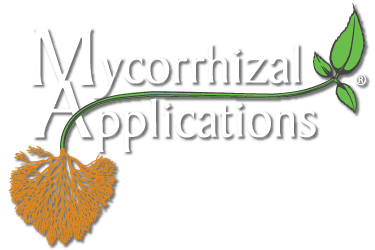By: Lauren María Alexander (Excerpt from Growing Produce, September 2016)
Taking a holistic approach to soil health is a key to increasing plant vigor and yields. High yields begin with healthy soil, and maintaining a proper balance between nutrients, microorganisms, and other compounds is an essential part of the soil health equation.
Mycorrhiza, which describes the symbiotic association between plants and a specialized root fungus, plays an important role in enhancing plant performance and growth.
Through this mutually beneficial relationship, mycorrhizal fungi colonize plants roots, enabling the roots to access nutrients and water that may otherwise be unavailable to plants.
Mike Amaranthus, founder of Mycorrhizal Applications, which focuses on the research and development of mycorrhizal inoculum for commercial use, explains exactly how these beneficial fungi work, and how you can use them to help improve overall plant health and increase yields.
What Are Mycorrhizae And How Do They Work?
According to Amaranthus, the relationship between Mycorrhizae and plant roots has been active for approximately 460 million years, and between 85% to 90% of plants form this relationship in their natural habitat.
“It’s one of those relationships where both the plant and the fungus benefit,” Amaranthus says. “The Mycorrhizae benefit the plant in allowing it to access nutrients and water that are essential for the plant’s performance and growth. In turn, the fungus depends on the plant for sugars from the plant roots, which give it the energy it needs to grow into the soil.”
The fungi act as “roots of the roots” and are fine threads that grow off of the roots themselves, Amaranthus says. They are especially important in the uptake of phosphorous, nitrogen, calcium, magnesium, and other key micronutrients that may be bound up organically or on soil particles.
Weed, Disease, And Drought Benefits
Not all plants form mycorrhizal associations, including crops such as kale, spinach, Brussels sprouts, canola, mustard, and sugar beets. But on the plus side, some of the world’s worst weeds do not form mycorrhizal associations either, Amaranthus says.
“Weeds come in following a disturbance in the soil, and disturbances knock out the Mycorrhizae. Without Mycorrhizae, the weeds get a competitive advantage and are better able to access phosphorous in the soil. If mycorrhizal fungi are established, you can help starve weeds of phosphorous,” he explains.
Regarding disease resistance, Amaranthus says that like many other fungi, Mycorrhizae produce antibiotics, which are capable of deterring root pathogens. They also have the capacity to selectively transport salt and toxic compounds away from plant roots.
“They depend on the roots for their energy source, so they want to keep the roots healthy, active, and growing. For this reason, the salt and the toxic compounds don’t get translocated to their cells,” he says.
Mycorrhizae’s benefits include drought protection due to roots’ improved ability to extend further into the soil to access water.
“Mycorrhizal roots are a lot spongier because they can get more water out of the soil, and they store them in specialized cells. They’re also much thinner so they can get into the small spaces in the soil where water is being held,” Amaranthus says.
A study Amaranthus conducted that was repeated by the University of California, Davis in 2013 showed almond trees inoculated with Mycorrhizae experienced a 60% reduction in plant moisture stress.
“Some of the studies have demonstrated six or seven days of growth in drought situations,” he says.
Application Methods
Mycorrhizae can be applied to the soil in granular, powder, and liquid forms.
“We grow the seeds of the Mycorrhizae, or what we call propagules. Mycorrhizal inoculums come in powder or granular forms. Growers can add water to the powder and add Mycorrhizae in the liquid form near the seed, they can coat the seed with the powder, which puts the inoculum right where the roots come out of the seed, or they can band the granular material in furrow,” Amaranthus says.
To maintain populations, he says that any practice that fosters root growth will foster mycorrhizal development. Mycorrhizal development is most rapid when soil temperatures are between 40°F to 70°F and when soil fertility levels are moderate. Fumigation eradicates mycorrhizal development and re-inoculation should be at least two weeks following fumigants.
“With Mycorrhizae, the bottom line for the end user is that they can get improved yields with less inputs. It’s a win-win situation,” Amaranthus says. “There’s an opportunity to save money, and it improves the efficiency of the plant’s ability to feed itself.”
Link to Original Article: http://www.growingproduce.com/vegetables/getting-to-the-root-of-improved-fruit-and-vegetable-production/
COPYRIGHT 2016 Growing Produce

